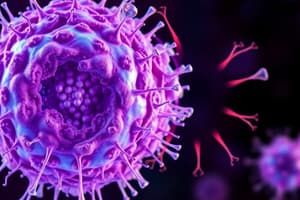Podcast
Questions and Answers
What is the basic unit of life in all living organisms?
What is the basic unit of life in all living organisms?
- Molecule
- Organ
- Cell (correct)
- Tissue
Which type of cell lacks a nucleus?
Which type of cell lacks a nucleus?
- Animal cells
- Eukaryotic cells
- Prokaryotic cells (correct)
- Fungal cells
Which of the following is not a characteristic of eukaryotic cells?
Which of the following is not a characteristic of eukaryotic cells?
- Larger size compared to prokaryotic cells
- Have a nucleus
- Contain circular DNA (correct)
- Have membrane-bound organelles
What organelle is known as the powerhouse of the cell?
What organelle is known as the powerhouse of the cell?
Which structure is unique to plant cells?
Which structure is unique to plant cells?
What type of cell division results in two identical daughter cells?
What type of cell division results in two identical daughter cells?
What is the main function of the Golgi apparatus?
What is the main function of the Golgi apparatus?
How do prokaryotic cells mainly reproduce?
How do prokaryotic cells mainly reproduce?
Study Notes
Overview of Cells
- Basic unit of life in all living organisms.
- Two main types: prokaryotic and eukaryotic cells.
Prokaryotic Cells
- Simple structure, no nucleus.
- Examples: bacteria and archaea.
- Characteristics:
- Small size (0.1 - 5.0 micrometers).
- DNA is circular and located in the nucleoid.
- Cell wall present (peptidoglycan in bacteria).
- Reproduction mainly through binary fission.
Eukaryotic Cells
- More complex, with a nucleus and membrane-bound organelles.
- Examples: animal cells, plant cells, fungi, and protists.
- Characteristics:
- Larger size (10 - 100 micrometers).
- DNA is linear and organized into chromosomes.
- Organelles include mitochondria, endoplasmic reticulum, Golgi apparatus, lysosomes, etc.
- Reproduction can be sexual (meiosis) or asexual (mitosis).
Key Organelles in Eukaryotic Cells
- Nucleus: Contains genetic material (DNA); control center of the cell.
- Mitochondria: Powerhouse of the cell; site of ATP (energy) production.
- Endoplasmic Reticulum (ER):
- Rough ER: Studded with ribosomes; synthesizes proteins.
- Smooth ER: Lacks ribosomes; synthesizes lipids and detoxifies.
- Golgi Apparatus: Modifies, sorts, and packages proteins and lipids for secretion.
- Lysosomes: Contains digestive enzymes to break down waste materials.
- Ribosomes: Sites of protein synthesis; can be free-floating or attached to the ER.
- Cell Membrane: Semi-permeable barrier that regulates what enters and exits the cell.
Plant vs. Animal Cells
- Plant Cells:
- Have a rigid cell wall made of cellulose.
- Contain chloroplasts for photosynthesis.
- Large central vacuole for storage and maintaining turgor pressure.
- Animal Cells:
- No cell wall; flexible shape.
- Smaller vacuoles compared to plant cells.
- Do not contain chloroplasts.
Cell Division
- Mitosis: Process of cell division resulting in two identical daughter cells; important for growth and repair.
- Meiosis: Specialized form of cell division that produces gametes (sperm and eggs) with half the chromosome number; essential for sexual reproduction.
Cell Theory
- All living organisms are composed of one or more cells.
- The cell is the basic unit of life.
- All cells arise from pre-existing cells.
Overview of Cells
- Cells are the basic unit of life in all living organisms.
- Two main types of cells: prokaryotic and eukaryotic.
Prokaryotic Cells
- Characterized by a simple structure and absence of a nucleus.
- Examples include bacteria and archaea.
- Size range: typically 0.1 to 5.0 micrometers.
- Contain circular DNA located in the nucleoid region.
- Possess a cell wall, primarily composed of peptidoglycan in bacteria.
- Reproduce mainly through binary fission.
Eukaryotic Cells
- More complex compared to prokaryotic cells, featuring a nucleus and membrane-bound organelles.
- Types include animal cells, plant cells, fungi, and protists.
- Larger size range: approximately 10 to 100 micrometers.
- DNA is linear and organized into chromosomes within the nucleus.
- Organelles include mitochondria, endoplasmic reticulum, Golgi apparatus, and lysosomes.
- Reproduction can occur through sexual reproduction (meiosis) or asexual reproduction (mitosis).
Key Organelles in Eukaryotic Cells
- Nucleus: Acts as the control center, housing genetic material (DNA).
- Mitochondria: Known as the powerhouse of the cell; primary site for ATP (energy) production.
- Endoplasmic Reticulum (ER):
- Rough ER: Studded with ribosomes, responsible for protein synthesis.
- Smooth ER: Lacks ribosomes, involved in lipid synthesis and detoxification processes.
- Golgi Apparatus: Modifies, sorts, and packages proteins and lipids for secretion.
- Lysosomes: Contain digestive enzymes to break down waste materials and cellular debris.
- Ribosomes: The sites of protein synthesis; can be either free-floating or attached to the ER.
- Cell Membrane: A semi-permeable barrier regulating the entry and exit of substances in and out of the cell.
Plant vs. Animal Cells
- Plant Cells:
- Feature a rigid cell wall made of cellulose for structural support.
- Contain chloroplasts, essential for photosynthesis.
- Possess a large central vacuole for storage and maintenance of turgor pressure.
- Animal Cells:
- Lack a cell wall, allowing for a flexible shape.
- Have smaller vacuoles in comparison to plant cells.
- Do not contain chloroplasts.
Cell Division
- Mitosis: A process of cell division producing two identical daughter cells, crucial for growth and repair.
- Meiosis: A specialized form of cell division producing gametes (sperm and eggs), reducing chromosome number by half for sexual reproduction.
Cell Theory
- All living organisms consist of one or more cells.
- The cell is recognized as the fundamental unit of life.
- All cells arise from pre-existing cells, highlighting continuity of life.
Studying That Suits You
Use AI to generate personalized quizzes and flashcards to suit your learning preferences.
Description
Explore the fundamental concepts of cellular biology through this quiz. Understand the differences between prokaryotic and eukaryotic cells, their structures, characteristics, and key organelles. Test your knowledge and deepen your comprehension of the basic unit of life.




